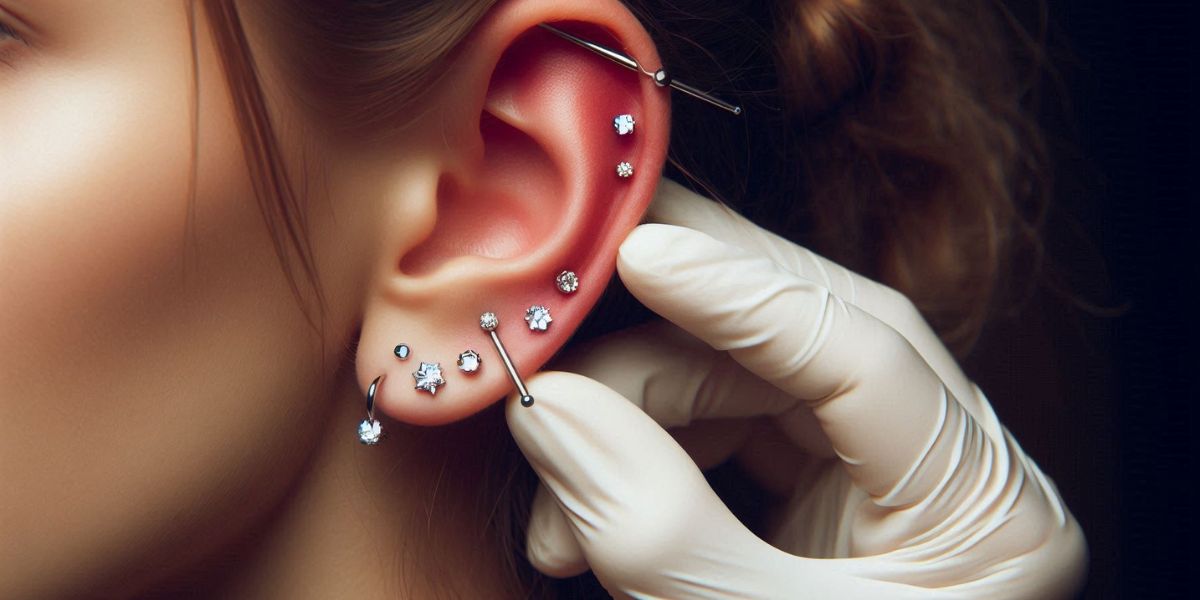Ear piercings have been an expression of style, culture, or beauty for practical purposes. You should know your options, how to care for them, and how to avoid infection before getting ear-based piercings. This article includes styles of piercings, aftercare, and tips to keep your ears safe.
There are different types of piercings you can choose from
From simple to elaborate ear piercing, today’s selection lets individuality shine. For the best style and comfort, know your options before visiting a piercer. Though the most common, these piercings are the easiest to start. Due to the fleshier lower part of the outer ear, piercings heal faster and hurt less than those in the cartilage. Standard lobe piercings are popular because they fit studs and small hoops. Higher-up earlobe piercings complement traditional ones.
People also love their cartilage piercings for their unique styles. These piercings, situated on the high cartilage of the ear, are more daring than lobe piercings and require a longer healing period. The helix, the outer rim of the ear, and the tragus, a small cartilage area above the opening to the ear canal, are fashionable and statement-making. You have the option to adorn your cartilage piercing with intricate, delicate jewelry or opt for a larger piece.
Finally, you can wear small studs or a hoop around your middle ear cartilage piercing. It takes a while to heal this piercing because cartilage is less vascular than lobes. Take care of your conch piercing, and it can complement your ear.
Important Steps to Prepare Before Getting a Piercing
Preparation is key to a piercing going smoothly, safely, and pleasantly. Selecting a skilled and reputable piercer is important. A trained professional, equipped with sterilized tools and hygienic practices, will advise you on the best piercing for your ear. Getting one of those piercings from an unlicensed shop may cause problems.
Select a trusted piercer with whom to discuss your health history, as certain health conditions could affect healing. You might try hypoallergenic jewelry (such as titanium or surgical steel) if you struggle with earring sensitivity. Avoid taking blood thinners such as aspirin and ibuprofen before your appointment, as they can increase bleeding. We recommend eating a balanced meal and drinking a lot of fluids before the piercing itself so you feel stable and don’t risk passing out.
An important next step includes mentally preparing for aftercare. All piercings require proper hygiene and come with a need for care. Learning about aftercare can motivate you to stick with the healing process and help keep your piercing free from bacteria.
Effective aftercare techniques for proper healing and maintenance
The ear is a very delicate area that can harbor bacteria, especially in the first few weeks of healing after there has been damage, so aftercare is vital to avoid infections and facilitate proper recovery. First, never touch your new piercing with dirty hands. Hands often harbor bacteria, which can spread to the area of a newly pierced piercing, increasing the likelihood of infections. Do not touch your ear; wash your hands as well.
Clean your piercing with saline twice every day. It is a mild solution that provides cleansing for the piercing without causing irritation. You can buy saline drops or make your own by mixing a quarter teaspoon of non-iodized salt in a cup of warm distilled water. Soak a cotton pad in the solution and place it on your piercing for a few minutes. Pat dry with a clean tissue.
When cleaning, do not rotate or twist your jewelry; it will disrupt the healing tissue and delay recovery. Do not allow your new piercing to go underwater in a swimming pool or hot tub where bacteria thrive and infections can set in. With these steps, your piercing will heal smoothly and allow you to enjoy it.
What to Do If You Encounter Common Piercing Issues?
Most piercings will heal without issues; however, complications may arise. Information about the most straightforward problems and their solutions can help you act quickly. Initial healing includes redness, swelling, and mild tenderness. However, pus or fever accompanying these symptoms indicates an infection. Do not take out the jewelry; it seals the hole with the infection. Seek medical advice instead.
Occasionally, similar to hypertrophic scarring or keloids, elevated stiff tissue may be present around the puncture site. Try silicone gel sheets or creams, but consult your dermatologist first. Use saline solution; most over-the-counter products such as hydrogen peroxide and alcohol are caustic to the area and add time to the healing process.
Using jewelry of the wrong material or improper fit could also irritate the piercing. If you are experiencing itching or reddening, consider trying hypoallergenic surgical steel, titanium, or nickel. Good jewelry minimizes risks and calms irritations with care.
Safeguarding your piercing for long-term enjoyment
Careful piercing selection and aftercare pay off in the long run. Ear-based piercings can be a gorgeous, permanent style statement if cared for and monitored properly. Keep your piercing clean and check for changes after the first week. The lobe, also known as cartilage, is a visually striking display of personality. You can keep your piercing safe and shiny by taking precautions.

